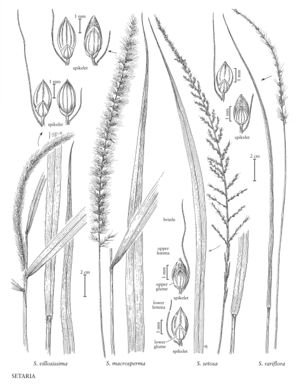Difference between revisions of "Setaria rariflora"
FNA>Volume Importer |
FNA>Volume Importer |
(No difference)
| |
Revision as of 19:22, 24 September 2019
Plants perennial. Culms 30-70 cm, usually erect, branching profusely at the base; nodes glabrous or sparsely hispid. Sheaths keeled, sparsely pubescent, margins ciliate distally; ligules to 1 mm, of hairs; blades 15-30 cm long, usually less than 5 mm wide, densely pubescent on both surfaces. Panicles 5-15 cm, slender, attenuate, interrupted, sparsely flowered; rachises pubescent; branches mostly shorter than 10 mm, villous; bristles usually solitary, 4-7 mm, antrorsely scabrous. Spikelets about 2 mm, ovate-lanceolate. Lower glumes about 1/3 as long as the spikelets, 3-veined; upper glumes about 1/2 as long as the spikelets, 5-7-veined; lower lemmas equaling the upper lemmas; lower paleas equaling the upper paleas, broad; upper lemmas finely and distinctly transversely rugose; upper paleas similar to the upper lemmas. 2n = unknown.
Distribution
Puerto Rico, Virgin Islands, Fla., Ala.
Discussion
Setaria rariflora has its center of distribution in South America. It is probably only recently adventive in North America, where it is known from Florida and the West Indies.
Selected References
None.
